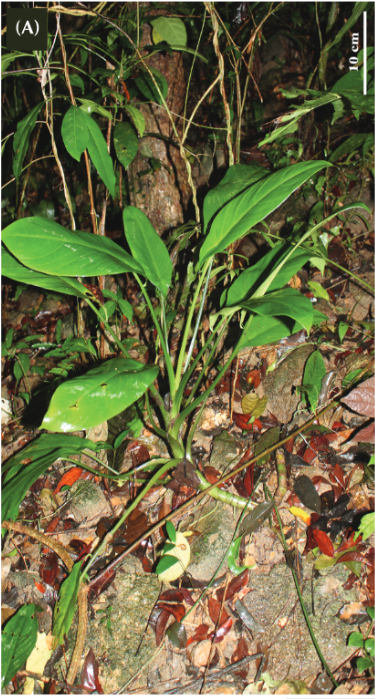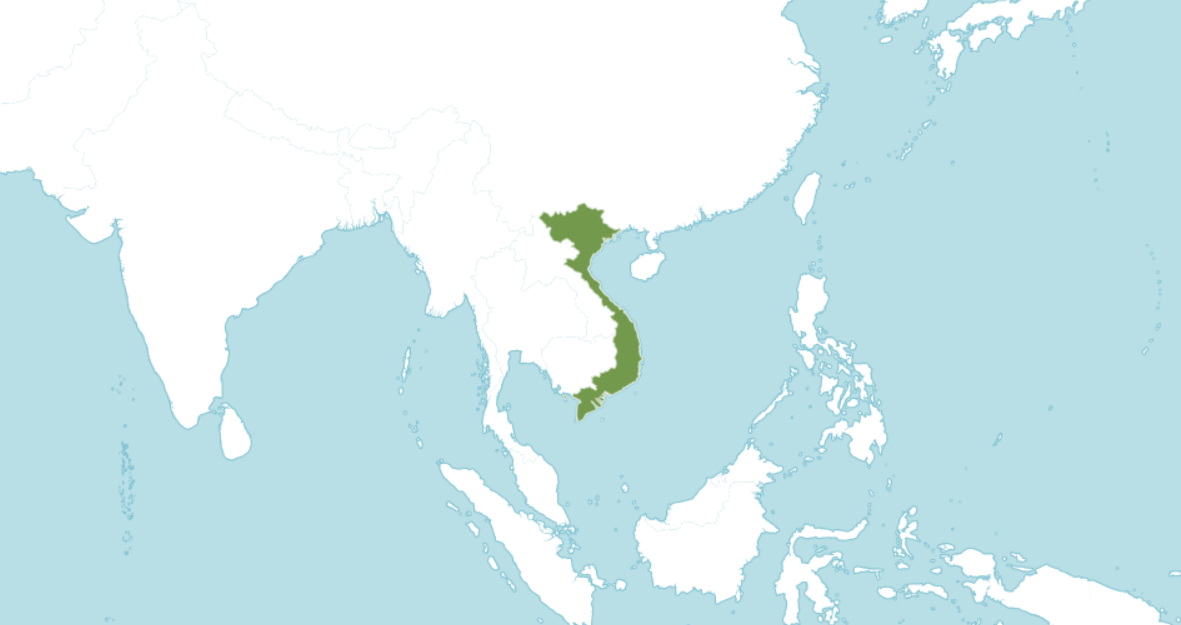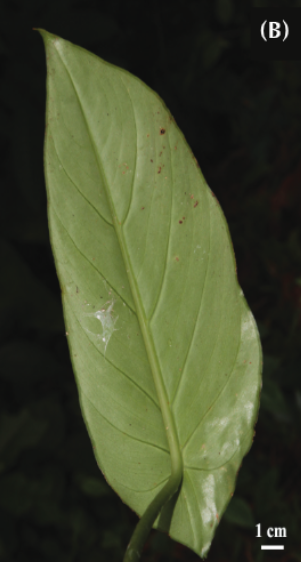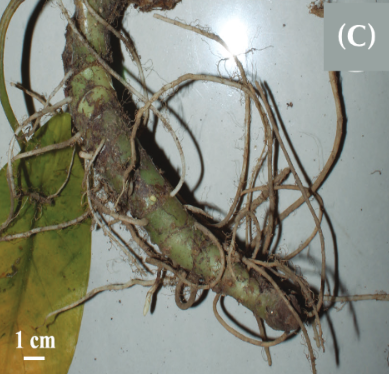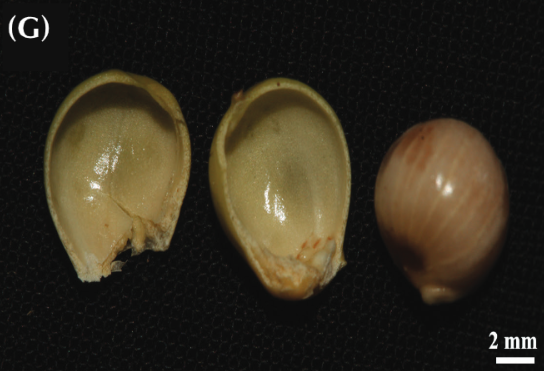ALOCASIA RIVULARIS
ORIGINAL DESCRIPTION:
Ah Alocasia scabriuscula in habitu calcicola, folii lamina plus producta, minus crassa, superne atro-viridi, spatha valde albida vel rosea differt.
TYPUS: Cuh. RBG Sydney Acc. No. 940541 ex Malaysia, Sarawak, Bau, Hay etal. 9388 (NSW, holo; iso, K, KEP, L, SAR, SING (to be distributed)).
[1Alocasia denudata auct. non Engl.: Ridl., J. Straits Br. Roy. Asiat. Soc. 44 (1905) 178.]
Vietnam. J. Sci. Technol. 59(2): 80 (2017)
The new species is morphologically similar to Alocasia peltata, Alocasia minuscula, Alocasia beccarii, Alocasia kerinciensis, and Alocasia perakensis, and differs in having no cataphylls interspersed with leaves, asymmetric leaf blades with the anterior lobe 5-6 times as long as combined posterior lobes, two inflorescences per axil, oblong ellipsoid, and longer fruiting spathes.
Type: VIETNAM. Quang Ngai Province, Nghia Hanh District, Hanh Tin Dong Commune, Nui Dau Mountain, 14°52’23.63”N, 108°48’49.48”E, around 80 m in elevation, 14 November 2015, Hong Truong Luu & Hoang Minh Duc Luu 1110 (holotype, SGN; isotypes, SGN & VNMN).
SYNONYMS: N/A
DISTRIBUTION: Vietnam, South-central province of Quang Ngai
CLIMATE: Tropical humid climate
Humidity is moderate throughout the year, ranging from 60% to 70%
Temperature is varies between the seasons - within the range of 48°F/9°C to 88°F/31°C during the day. Minimum temperatures never dip below 45°F/7°C
Rainy and humid season (October to May) and a dry season between June and October. The average annual rainfall is 1,200 mm
ECOLOGY: Alocasia rivularis is found in the lowland evergreen tropical forests on fertile soils along small streams and ponds; fruits were seen in November.
SPECIES DESCRIPTION:
Herbs to 70 cm tall have the following characteristics: Stem rhizomatous, elongate, slender, unbranched, and 20-26 mm in diameter, with internodes nearly as wide as long, as well as decumbent and then erect, and often completely exposed. Also having leaves ranging from several to 11, clustered at the tips of stems, peltate, and drying brown; petioles pale green, glabrous, and 25-35 cm long; petiolar sheath 8-15 cm long, mostly persistent; blades narrowly lanceolate to oblong-ovate, asymmetric, sized 16-24x 7-8.5 cm, shining, and thinly coriaceous on both surfaces, adaxially dark green, and abaxially pale green; midribs adaxially impressed, and abaxially prominent; anterior lobes 12-20 cm long, with 1 cm long acuminate tip, which are 5-6 times as long as the combined posterior lobes; anterior costae with four adaxially impressed, abaxially prominent primary lateral veins on each side (subopposite) diverging at ca. 45-60° which run straight or upcurved into a conspicuous intramarginal vein 1-1.5 mm from the margin; secondary venations inconspicuous to be invisible; posterior lobes completely united except for a 1.5-2 mm incision at the extreme base of the leaf; and combined posterior lobes 3-4 cm long, which are widest at the petiole insertion.
INFLORESCENCE:
Also, infructescences two, peduncle 18-24 cm, 6-8 mm in diameter; fruiting spathes which are dark green, oblong ellipsoid 6.5-7.5 cm long, ca. 2 cm in diameter, and opened at the middle; fruits obovoid, pale greenish yellow, and usually 7 mm in diameter; and seeds 1 and rarely 2, round, pale pinkish to brownish white, with longitudinal white veins, which are 5-6 mm in diameter.
VARIEGATED FORMS: N/A
ETYMOLOGY: The specific epithet comes from the Latin rivularis, meaning "of a brook". Named to reflect the typical habitat of the species, which grows along small streams and ponds.
NOTES:
Morphologically, Alocasia rivularis closely resembles Alocasia peltata, which is distributed in Borneo, in scattered localities in Sarawak, Brunei, and central Kalimantan. Both species share similar shapes and dimensions of leaves, fruits and seeds as well as the diameter of stem. However, Alocasia peltata is readily distinguishable from the Vietnamese congener due to its height of ca. 30 cm, fewer leaves, symmetric leaf blades, an anterior lobe 2-3 times as long as the combined posterior lobes, 5-6 ovuled ovaries, an inflorescence per axil, and obovoid fruiting spathes [4, 11]. Further, Alocasia peltata is distributed in the mossy forest floor on ridges at ca. 1,200 m altitude, while our species are found in the dipterocarp-dominated lowland tropical evergreen forest at around 80 m altitude. The shape of the leaf blades in Alocasia rivularis also looks similar to that of the Alocasia minuscula from Sarawak, but the latter has a smaller size (height of 10-20 cm and stem of ca. 1 cm diameter, very thick and smaller leaf blades (8-13x2-3 cm), more primary lateral veins (8-10 on each side of midrib), striate secondary venation, and shorter petioles (5-10 cm long) with shorter petiole sheaths (ca. 1/7 of petiole length). Three other Alocasia species that have leaf blades similar to those in Alocasia rivularis are Alocasia beccarii from northwestern Borneo are Alocasia perakensis from Peninsula Malaysia and Thailand, and Alocasia kerinciensis A.Hay from Sumatra (Indonesia) and but these three latter, like the two compared just above, are readily distinguishable from our new species by their cataphylls interspersed with leaves and symmetric leaf blades. In addition to that, Alocasia beccarii and Alocasia kerinciensis are different from Alocasia rivularis because Alocasia beccarii has a small habit (12-28 cm tall), a slender stem that is 5-10 mm in diameter, very long internodes, ca. 2 cm long, and ovoid fruiting spathes, while Alocasia kerinciensis has a smaller stem (1 cm diameter, and up to ca. 40 cm long) with internodes that are 5 cm long, an anterior costa with 2-3 primary lateral veins on each side, and smaller ovoid fruiting spathes (ca. 2 cm long). Alocasia perakensis is further distinct from A. rivularis in having thick leaf blades, ovoid fruiting spathes, ellipsoid, and red fruits.
CULTIVARS: N/A
HYBRIDS: N/A

